ACTIVATED by the signing of the Treaty of Chaguaramas on July 4, 1973, the Caribbean Community and Common Market (CARICOM) is a shared market, comprising 20 states and dependencies in the Caribbean that have collectively joined to expand trade and economic relations with international players. CARICOM emerged as a replacement to the Caribbean Free Trade Association (CARIFTA) (1965) which failed to allow the free movement of labor and capital, as well as the harmonization of industrial and foreign policies throughout the region. An earlier effort was made at functional cooperation and political union in the region through the formation of the West Indies Federation in 1958.
In 2002, the Treaty was revised to allow for the eventual establishment of a Single Market and Economy – termed CSME (CARICOM Single Market and Economy).
The Community rests on four main pillars: economic integration, foreign policy coordination, human and social development, and security.
These pillars, according to CARICOM, underpin the stated objectives of the Community. These include; to improve standards of living and work; full employment of labour and other factors of production; accelerated, coordinated and sustained economic development and convergence; expansion of trade and economic relations with Third States; enhanced levels of international competitiveness; organization for increased production and productivity; achievement of a greater measure of economic leverage; effectiveness of Member States in dealing with Third States, groups of States and entities of any description; and the enhanced coordination of Member States’ foreign and foreign economic policies and enhanced functional cooperation.
Only fifteen participating members in CARICOM are full members, leaving five members with Associate Member status.
The 15 member-states include; Antigua and Barbuda, The Bahamas, Barbados, Belize, Dominica, Grenada, Guyana, Haiti, Jamaica, Montserrat, St. Lucia, St. Kitts and Nevis, St. Vincent and the Grenadines, Suriname and Trinidad and Tobago. The Associate members include; Anguilla, Bermuda, British Virgin Islands, Cayman Islands and Turks and Caicos Islands.
Stretching from The Bahamas in the north to Suriname and Guyana in South America, the regional bloc comprises states which are considered developing countries. With the exception of Belize in Central America and Guyana and Suriname on the coast of South America, all Members and Associate Members are island states.
According to CARICOM, the region is home to approximately sixteen million citizens, 60 per cent of whom are under the age of 30, and from the main ethnic groups of Indigenous Peoples, Africans, East Indians, Europeans, Chinese and Portuguese. While states are all relatively small, both in terms of population and size, there is also great diversity with regards to geography and population as well as the levels of economic and social development.
The Community is multi-lingual; with English as the main language complemented by French and Dutch and variations of these, as well as African and Indian expressions.
CARICOM is the oldest surviving integration movement in the developing world and according to the Community, its achievements along the way are many. Its secretariat is located in Georgetown.
“Great strides have been made, particularly through functional cooperation in education, in health, in culture, in security. Its Single Market functions, and it is a respected voice in international affairs because of a coordinated foreign policy” CARICOM contends.
History of CARICOM
SHARE THIS ARTICLE :
Facebook
Twitter
WhatsApp



.jpg)










